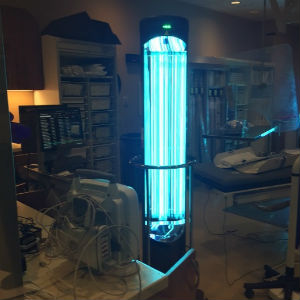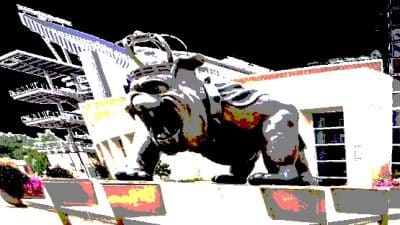
It’s a Surfacide Helios Disinfection System, and it significantly controls bacteria, spores and virus including C.diff (clostridium difficle) and MRSA that are known to colonize hard surfaces in patient care environments.
The system uses ultra-violet (UV-C) light energy, which is an evidenced-based disinfection way to control microorganisms. The new technology, partially purchased with funds from a VHHA (Virginia Hospital & Healthcare Association) Ebola/Emerging Pathogens Grant to Augusta Health, uses three separate transmitters that communicate with each other and can treat an entire room in 20 to 40 minutes.
So while it’s been designed to be tough enough to kill Ebola, it’s used also being used by Augusta Health and other healthcare facilities much more practically on C.diff and MRSA on a regular basis. Either way, Surfacide is providing the patients at Augusta Health an additional level of care aimed to decrease the possibility of acquiring a healthcare-associated infection from resistant bacteria and viruses.
The professionals at Augusta Health have been impressed with its function and what it has accomplished for our patients: Infection Control Preventionist Tracy Sansossio, MSN-IPC RN CMSRS, says:
“We view the Surfacide as a ‘colleague’ in infection prevention. Our Environmental Services staff does an exceptional job in daily cleaning and disinfecting. Surfacide provides an additional layer of safety and infection control by treating high priority areas. We rotate the system through our operating rooms, discharge isolation rooms, cardiac cath labs and oncology infusion areas. We’ve also treated rooms in our Joint Center and Nursery. The results have been outstanding. The 360° rotation of the UV light by the three towers hits the majority of surfaces in the room and the towers actually disinfect themselves in the process.”
Hesston Johnson, Director of Environmental and Linen Services adds:
“We test the effectiveness of our cleaning on a regular basis, and we are always consistently well within the safe standards. We’ve tested the Surfacide on rooms after patients with C.diff, which is especially hard to kill. We swabbed surfaces, and sent cultures to the lab—at discharge, after our ‘terminal clean’, and then after Surfacide. The post-Surfacide treatment swabs showed absolutely 0 growth on all surfaces.”
So how does it work?
It’s almost like a robot—or at least a smart phone. It has impressive safety mechanisms to keep employees and patients safe. It maps the room, tells you how long it will take to clean, and tells you when it’s done.
Augusta Health is an independent, community-owned, not-for-profit hospital whose mission is to promote the health and well-being of its community through access to excellent care. Named one of the 100 Top Hospitals in America by Thomson Reuters/Truven in both 2011 and 2012, Augusta Health has also been nationally recognized by HealthGrades as one of America’s 50 Best Hospitals for clinical excellence and patient safety for two consecutive years.
For more information about Augusta Health, its programs or its services, please visit the website, www.augustahealth.com.










